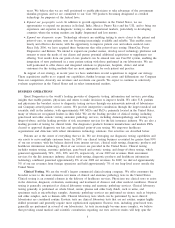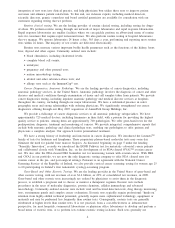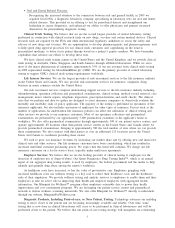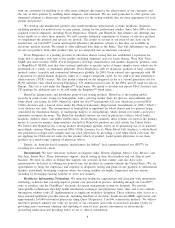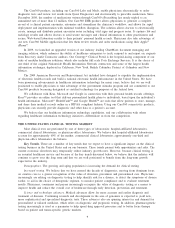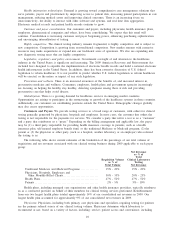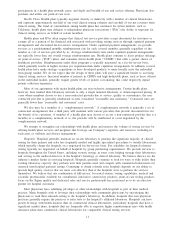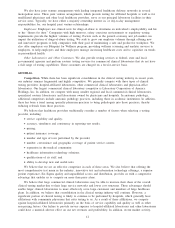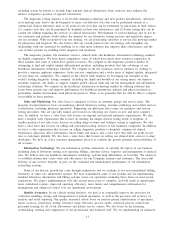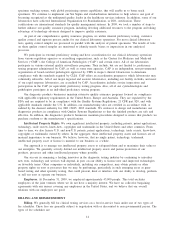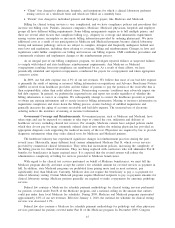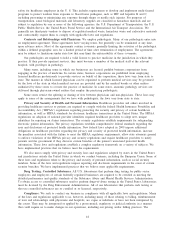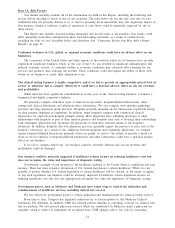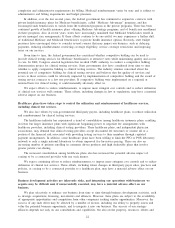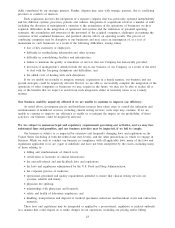Quest Diagnostics 2009 Annual Report Download - page 23
Download and view the complete annual report
Please find page 23 of the 2009 Quest Diagnostics annual report below. You can navigate through the pages in the report by either clicking on the pages listed below, or by using the keyword search tool below to find specific information within the annual report.including actions by payers to exclude large national clinical laboratories from contracts, may enhance the
relative competitive position of regional laboratories.
The diagnostic testing industry is faced with changing technology and new product introductions. Advances
in technology may lead to the development of more cost-effective tests that can be performed outside of a
commercial clinical laboratory such as (1) point-of-care tests that can be performed by physicians in their offices;
(2) complex tests that can be performed by hospitals in their own laboratories; and (3) home testing that can be
carried out without requiring the services of clinical laboratories. Development of such technology and its use by
our customers and patients would reduce the demand for our laboratory testing services and negatively impact
our net revenues. With our point-of-care test strategy, we are positioning ourselves to service this growing market
for physicians and hospitals. We also believe that our overall point-of-care test strategy will strengthen our
relationship with our customers by enabling us to offer more solutions that improve their effectiveness and the
care of their patients by enabling faster diagnosis and treatment.
The diagnostic product, life insurance services, clinical trials and healthcare information technology markets
are highly competitive. We have many competitors, some of which have much more extensive experience in
these markets and some of which have greater resources. We compete in the diagnostic products market by
attempting to find and exploit unique differentiated products, including products that take advantage of our
healthcare information technology solutions. We compete in the life insurance services business by seeking to
provide a superior applicant experience, faster services completion and a wider array of highest quality, integrated
services than our competitors. We compete in the clinical trials business by leveraging our strengths as the
world’s leading diagnostic testing company, including the depth and breadth of our testing menu, our superior
scientific expertise, our ability to support complex global clinical trials and our lab management and information
technology solutions. We compete in the healthcare information technology market by offering solutions that
foster better patient care and improve performance for healthcare institutions, patients and physician practices,
particularly smaller and medium sized physician practices. There is no guarantee that we will be able to compete
successfully in these markets.
Sales and Marketing. Our sales force is organized to focus on customer groups and service types. The
majority of representatives focus on marketing clinical laboratory testing, anatomic pathology and related services
to physicians, including physician specialists. Supporting our physician sales teams are genomics and esoteric
testing specialists, who are specially trained and focused on educating our clients on new and more complex
tests. In addition, we have a sales force that focuses on regional and national insurance organizations. We also
have a hospital sales organization that focuses on meeting the unique clinical testing needs of hospitals. A
smaller portion of our sales force focuses on selling drugs-of-abuse and wellness testing to employers. We also
have a sales force that focuses on selling risk assessment testing services to life insurance companies. In addition,
we have a sales organization that focuses on selling diagnostic products to hospitals, commercial clinical
laboratories, physician office laboratories, blood banks and clinics, and a sales force that sells our point-of-care
tests to customers globally. We also have a sales force that focuses on selling our clinical trials services to drug
developers. We have an active customer management process to evaluate the growth potential and profitability of
all accounts.
Information Technology. We use information systems extensively in virtually all aspects of our business,
including clinical laboratory testing, test reporting, billing, customer service, logistics and management of medical
data. We believe that our healthcare information technology systems help differentiate us favorably. We endeavor
to establish systems that create value and efficiencies for our Company, patients and customers. The successful
delivery of our services depends, in part, on the continued and uninterrupted performance of our information
technology systems.
Some of our historic growth has come through acquisitions and we continue to use non-standardized billing,
laboratory or other core information systems. We have standardized some of our systems and are implementing
standard laboratory information and billing systems across our operations, including those from our most recent
acquisitions. We expect implementation will take several more years to complete, and will result in significantly
more centralized systems, improved operating efficiency, more timely and comprehensive information for
management and enhanced control over our operational environment.
Quality Assurance. In our clinical testing business, our goal is to continually improve the processes for
collection, handling, storage and transportation of patient specimens, as well as the precision and accuracy of
analysis and result reporting. Our quality assurance efforts focus on positive patient identification of specimens,
report accuracy, proficiency testing, reference range relevance, process audits, statistical process control and
personnel training for all of our laboratories and patient service centers. We also focus on the licensing,
credentialing, training and competence of our professional and technical staff. We are implementing an enhanced
13


